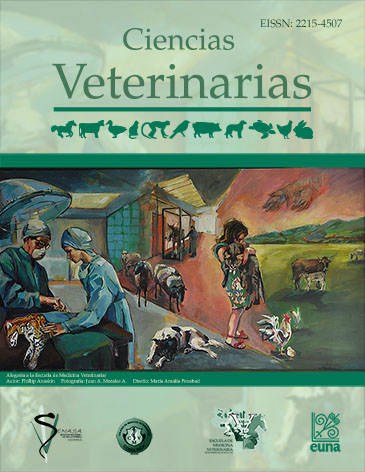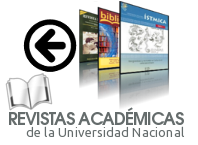A coproparasitological survey of gastrointestinal helminths in black vultures (Coragyps atratus) from Livingston, Izabal, Guatemala
DOI:
https://doi.org/10.15359/rcv.37-2.4Keywords:
Coragyps atratus, helminths, helminth ova, trematodesAbstract
The aim of this study was to determine the presence of gastrointestinal helminths in black vultures (Coragyps atratus) from an area in Livingston, Izabal, Guatemala, using coproparasitological analysis. Thirty-two fecal samples from these birds were analyzed by the direct smear method and the saturated sugar solution flotation method. Out of the 32 analyzed fecal samples, 21 (65.6%) tested positive for gastrointestinal helminth ova and, out of these, 20 (95.2%) presented trematode ova, 3 (14.3%) nematode ova, and 1 (4.8%) acanthocephalan ova. Eggs of a trematode of the superfamily Diplostomoidea were the most commonly observed, being detected in 20 (62.5%) out of the 32 samples analyzed. Furthermore, samples contained trematode eggs from the family Echinostomatidae, nematode eggs from the genus Heterakis and the families Ascarididae and Trichostrongylidae, as well as eggs of Acanthocephala. Based on the coproparasitological analysis, the evaluated black vultures had gastrointestinal helminths, with the predominance of a trematode species of the superfamily Diplostomoidea. The findings of this research constitute the first approach to learning about the gastrointestinal helminthological fauna of Coragyps atratus in Guatemala.
References
Adams, A. M., Murrell, K. D. & Cross, J. H. 1997. Parasites of fish and risks to public health. Rev. Sci. Tech. OIE 16(2): 652–660. DOI: dx.doi.org/10.20506/rst.16.2.1059
Alves-Pinto, H. 2013. Biología e taxonomía de trematódeos transmitidos por moluscos dulciaquícolas na Represa da Pampulha, Belo Horizonte, Minas Gerais, Brasil. Tesis de Doctorado en Parasitología. Universidade Federal de Minas Gerais, Belo Horizonte, Brasil.
Andery, D. de A., Ferreira-Junior, F.C., Araújo, A. V., Vilela, D. A. da R., Marques, M.V.R., Marin, S.Y., Horta, R.S., Ortiz, M.C., Resende, J.S. & Martins, N.R. da S. 2013. Health assessment of raptors in triage in Belo Horizonte, MG, Brazil. Braz. J. Poult. Sci. 15(3): 247–256. DOI: dx.doi.org/10.1590/S1516-635X2013000300012
Avery, M. L. & Lowney, M. 2016. Vultures. Wildlife Damage Management Technical Series. USDA, APHIS, WS National Wildlife Research Center, Fort Collins, Colorado. p. 9–12.
Ballejo, F. & De Santis, L.J.M. 2013. Dieta estacional del jote cabeza negra (Coragyps atratus) en un área rural y una urbana en el noroeste patagónico. El Hornero 28(1): 7–14.
Basch P.F., DiConza J.J. & Johnson B.E. 1973. Strigeid trematodes (Cotylurus lutzi) cultured in vitro: Production of normal eggs with continuance of life cycle. J. Parasitol. 59(2): 319–322. DOI: 10.2307/3278824
Bildstein, K. L., Bechard, M. J., Porras, P., Campo, E. & Farmer, C. J. 2007. Seasonal abundances and distributions of black vultures (Coragyps atratus) and turkey vultures (Cathartes aura) in Costa Rica and Panama: Evidence for reciprocal migration in the neotropics. In Bildstein, K. L., Barber, D. R. & Zimmerman, A. (Eds.), Neotropical Raptors: Proceedings of the Second Neotropical Raptors Network Congress. Hawk Mountain Sanctuary, Orwigsburg, Pennsylvania. p.47–60.
Blasco-Costa, I. & Locke, S. A. 2017. Life history, systematics and evolution of the Diplostomoidea Poirier, 1886: Progress, promises and challenges emerging from molecular studies. Adv. Parasitol. 98:167–225. DOI: doi.org/10.1016/bs.apar.2017.05.001
Borgsteede, F.H.M. 1996. The effect of parasites on wildlife. Veterinary Quarterly 18(3): 138–140. DOI: doi.org/10.1080/01652176.1996.9694717
Born-Torrijos, A., Poulin, R., Pérez-del-Olmo, A., Culurgioni, J., Raga, J. A. & Holzer, A. S. 2016. An optimised multi-host trematode life cycle: fishery discards enhance trophic parasite transmission to scavenging birds. Int. J. Parasitol. 46(11): 745–753. DOI: doi.org/10.1016/j.ijpara.2016.06.005
Bowman, D. 2014. Georgis’ Parasitology for Veterinarians, 10th edition. Elsevier Saunders, St. Louis, Missouri. p. 326-398.
Bustamante, J. 2013. Morfometría corporal y parásitos gastrointestinales del cóndor andino (Vultur gryphus) en estado silvestre y cautiverio en los departamentos de Apurímac y Cusco, 2012. Tesis para optar al título de Médico Veterinario y Zootecnista. Universidad Católica de Santa María, Arequipa, Perú.
Chai, J.Y., Sohn, W.M., Chung, H.L., Hong, S.T. & Lee S.H. 1990. Metacercariae of Pharyngostomum cordatum found from the European grass snake, Rhabdophis tigrina, and its experimental infection to cats. Korean J. Parasitol. 28(3):175–181. DOI: dx.doi.org/10.3347/kjp.1990.28.3.175
De la Cruz, J. R. 1982. Clasificación de zonas de vida de Guatemala a nivel de reconocimiento. Ministerio de Agricultura, Ganadería y Alimentación (MAGA), Guatemala. p.11–36.
Drago, F. B. & Lunaschi, L. I. 2011. Digenean parasites of Ciconiiform birds from Argentina. Rev. Mex. Biodivers. 82(1): 77–83.
Ferguson-Lees, J. & Christie, D. A. 2001. Raptors of the World. Houghton Mifflin Harcourt, Boston. p.305–306.
Figueroa-Hernández, L. & Rodríguez-Zea, M. 2007. Manual de técnicas diagnósticas en parasitología veterinaria. Facultad de Medicina Veterinaria y Zootecnia, Universidad de San Carlos de Guatemala, Guatemala. p.11–14.
Frasson, L., Wolkmer, P., Soares, J., Rosa, L., Marchesan, C., Ferreira, E., Salomão, E. & Buiz, T. 2016. Pesquisa de ectoparasitas e analise coproparasitológica de animais silvestres mantidos em cativeiro no Zoológico de Cachoeira do Sul-RS do Brasil. I Conferência e Mostra Científica Internacional Em Bem-Estar Animal. Itapiranga, Santa Catarina, Brasil.
Gibson, D. I. 1996. Trematoda. In Margolis, L. & Kabata, Z. (Eds.), Guide to the parasites of fishes of Canada. Part IV. Canadian Special Publication of Fisheries and Aquatic Sciences 124, Ottawa. p.133.
Globokar, M., Fischer, D. & Pantchev, N. 2017. Occurrence of endoparasites in captive birds between 2005 to 2011 as determined by faecal flotation and review of literature. Berliner und Münchener tierärztliche Wochenschrift 130(11/12): 461–473. DOI: 10.2376/0005-9366-16094
Goater, T.M., Goater, C.P. & Esch, G.W. 2014. Parasitism: The Diversity and Ecology of Animal Parasites, 2nd Edition. Cambridge University Press, New York, p.396-431.
Hong S.T., Cho T.K., Hong S.J., Chai J.Y., Lee S.H. & Seo B.S. 1984. Fifteen human cases of Fibricola seoulensis infection in Korea. Korean J. Parasitol. 22(1): 61–65. DOI: dx.doi.org/10.3347/kjp.1984.22.1.61
Houston, D. & Kirwan, G. M. 2019. American Black Vulture (Coragyps atratus). https://www.hbw.com/species/american-black-vulture-coragyps-atratus. (Accessed 4 March 2019).
INSIVUMEH (Instituto Nacional de Sismología, Vulcanología, Meteorología e Hidrología). 2018. Normales climáticas. http://www.insivumeh.gob.gt/normas-climaticas/ (Accessed 11 November 2018).
Kaenjampa, P., Tangkawattana, S., Smith, J., Sukon, P. & Tangkawattana, P. 2017. Elimination of Haplorchis taichui metacercaria in cyprinoid fish with freezing temperature and soured fish (plasom) with salinity. Southeast Asian J. Trop. Med. Public Health 48(4): 777–785.
Kostadinova, A., Vaucher, C. & Gibson, D. I. 2002. Redescriptions of two echinostomes from birds in Paraguay, with comments on Drepanocephalus Dietz, 1909 and Paryphostomum Dietz, 1909 (Digenea: Echinostomatidae). Systematic Parasitology 53(2): 147–158. DOI: doi.org/10.1023/A:1020418124561
Krone, O. 2007. Endoparasites. In: Bird D.M. & Bildstein K.L. (Eds.), Raptor research and management techniques. Hancock House, Surrey, British Columbia and Blaine, Washington. p. 318–328.
Lie, K. J. & Basch, P. F. 1967. The life history of Paryphostomum segregatum Dietz, 1909. J. Parasitol. 53(2): 280–286. DOI: 10.2307/3276576
Loker, E.S. & Hofkin, B.V. 2015. Parasitology: A conceptual approach. Garland Science, Taylor & Francis Group, New York and Abingdon, Oxfordshire. p. 219-221, 344-345.
López-Hernández, D. D. 2018. Estudo morfológico e molecular de larvas de Diplostomoidea (Trematoda: Digenea) transmitidas por moluscos dulciaquícolas em Belo Horizonte, Minas Gerais, Brasil. Tesis de Maestría en Parasitología. Universidade Federal de Minas Gerais, Belo Horizonte, Brasil.
Lunaschi, L. I. & Drago, F. B. 2009. Species of Strigea (Digenea: Strigeidae), parasites of the savanna hawk Buteogallus meridionalis (Aves: Accipitridae) from Argentina, with the description of a new species. Folia Parasitol. 56(4): 268–274. DOI: 10.14411/fp.2009.031
Navone, G.T., Gamboa, M.I., Kozubsky, L.E., Costas, M.E., Cardozo, M.S., Sisliauskas, M.N. & González, M. 2005. Estudio comparativo de recuperación de formas parasitarias por tres diferentes métodos de enriquecimiento coproparasitológico. Parasitol. latinoam. 60(3–4):178–181. DOI: dx.doi.org/10.4067/S0717-77122005000200014
Noronha, D., Sá, M. R., Knoff, M., Muniz-Pereira, L. C. & Pinto, R. M. 2009. Adolpho Lutz e a coleção helmintológica do Instituto Oswaldo Cruz. Museu Nacional, Rio de Janeiro. p.73–136.
Raffaele, H., Wiley, J., Garrido, O., Keith, A. & Raffaele, J. 2003. Birds of the West Indies. Princeton University Press, Princeton, New Jersey. p.80.
Rotella, I. J., Silveira, E. A., Delgado, L., González, O., Remón, S., Rojas, D., Gónzalez, J.A., Manso, M.J., Perdomo, J.R. & Campos, R. 2006. Contribución al conocimiento de la epizootiología y biología del Cathartes aura Lin. REDVET 7(1): 1–12.
Sarmiento, L., Tantaleán, M. & Huiza, A. 1999. Nematodos parásitos del hombre y de los animales en el Perú. Rev. Peru. Parasitol. 14(1–2): 9–65.
Schlatter, R., Reinhardt, G. & Burchard, L. 1978. Estudio del jote (Coragyps atratus foetens, Lichtenstein) en Valdivia: Etología carroñera y rol en diseminación de agentes patógenos. Arch. Med. Vet. 10(2): 111–127.
Smith, S.A. 1993. Diagnosis and treatment of helminths in birds of prey. In: Redig, P.T., Cooper, J.E., Remple, D., & Hunter, B. (Eds.), Raptor Biomedicine. University of Minnesota Press, Minneapolis, Minnesota. p. 21–27.
Taylor, M.A., Coop, R.L. & Wall, R.L. 2016. Veterinary Parasitology, 4th edition. Wiley Blackwell, Ames, Iowa. p. 82, 261-267.
Thienpont, D., Rochette, F. & Vanparijs, O.F.J. 2003. Diagnosing helminthiasis by coprological examination. Janssen Animal Health, Beerse, Belgium. p.29-203.
Tkach, V. V., Kudlai, O. & Kostadinova, A. 2016. Molecular phylogeny and systematics of the Echinostomatoidea Looss, 1899 (Platyhelminthes: Digenea). Int. J. Parasitol. 46(3): 171–185. DOI: doi.org/10.1016/j.ijpara.2015.11.001
Toledo, R., Muñoz-Antoli, C. & Esteban, J.G. 2014. Intestinal Trematode Infections. In: Toledo, R. & Fried, B. (Eds.), Digenetic tremadode infections. Advances in Experimental Medicine and Biology. Springer, New York. p. 201–240. DOI: doi.org/10.1007/978-1-4939-0915-5_7
Travassos, L. 1917. Contribuições para o conhecimento da fauna helmintolojica brazileira. VI. Revisão dos acantocefalos brazileiros. Parte I. Fam. Gygantorhynchidae Hamann, 1892. Mem. Inst. Oswaldo Cruz 9(1): 5–62. DOI: dx.doi.org/10.1590/S0074-02761917000100001
Vicente, J. J., Rodrigues, H. de O., Gomes, D. C. & Pinto, R. M. 1995. Nematóides do Brasil. Parte IV: Nematóides de aves. Rev. Bras. Zool. 12: 1–273. DOI: dx.doi.org/10.1590/S0101-81751995000500001
Zajac, A. M. & Conboy, G. A. 2012. Veterinary clinical parasitology, 8th ed. Wiley-Blackwell, Ames, Iowa. p.4–14, 19–169.
Published
How to Cite
Issue
Section
License
Licensing of articles
All articles will be published under a license:

Licencia Creative Commons Atribución-NoComercial-SinDerivadas 3.0 Costa Rica.
Access to this journal is free of charge, only the article and the journal must be cited in full.
Intellectual property rights belong to the author. Once the article has been accepted for publication, the author assigns the reproduction rights to the Journal.
Ciencias Veterinarias Journal authorizes the printing of articles and photocopies for personal use. Also, the use for educational purposes is encouraged. Especially: institutions may create links to specific articles found in the journal's server in order to make up course packages, seminars or as instructional material.
The author may place a copy of the final version on his or her server, although it is recommended that a link be maintained to the journal's server where the original article is located.
Intellectual property violations are the responsibility of the author. The company or institution that provides access to the contents, either because it acts only as a transmitter of information (for example, Internet access providers) or because it offers public server services, is not responsible.







